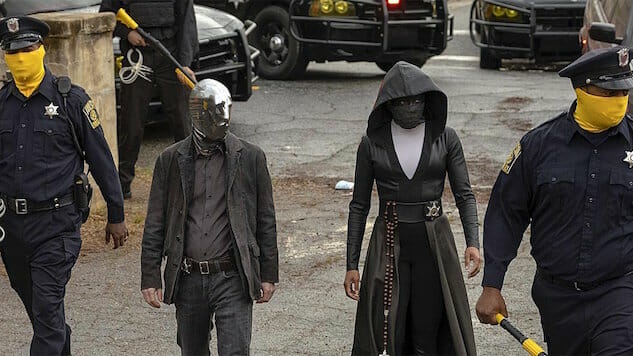Why Watchmen Had to Be the Most Detail-Obsessed Show on TV
"The level of detail really needed to be there in order for it to call itself Watchmen," said executive producer Damon Lindelof.
Photo Courtesy of HBO
[Note: The following contains mild spoilers for the season premiere of Watchmen.]
It is very, very easy to nerd out over HBO’s Watchmen while talking to Damon Lindelof. The executive producer of the new HBO drama took on the challenge of expanding upon one of his all-time favorite stories with a great deal of nervousness, ultimately creating the story of what happened to this dark weird world of costumed heroes after the events of the iconic 1986 comic book series by Alan Moore and Dave Gibbons.
Lindelof pinpointed two key ideas that sparked inspiration for his take on the show: “I got really wrapped up in the idea that a mask would simultaneously conceal and reveal, and that that idea felt paradoxical,” he said. “And so I was like, it hides your face, but it also shows who you really are. And I was like, I want to talk about that. I don’t know what that means.”
In addition, as he’s discussed more than once, he wanted to examine the issue of race and America, “and how I felt everything that I was seeing around me in the media was a reflection of these sorts of these dual histories, what I will call the story that I was told versus the versus the story that was hidden. And I started asking myself if Watchmen, as a word, an idea, a concept, could contain a conversation on race.”
While Lindelof was a massive fan of the comics from the beginning, director Nicole Kassell was not — her first exposure to Watchmen came through Lindelof’s script for the pilot. However, she said, “I was blown away. ‘I had to do this’ was the feeling that came over me.”
However, she still held off on reading the graphic novel until after she officially got the job as producing director on the series, feeling that “the fact that I wasn’t a fan would give me fresh eyes to taking in the story, he was telling without judging it against something else.” Once she came on board, she then began a deep dive into the comic and its surrounding mythology. “I realize that I’ve still only scratched the surface. But once I was a part of the team, it was essential to me to be, you know, incredibly responsible and respectful to the source. And the fans that come with it.”
Almost every frame of the show is packed with details that speak to the differences between the world of Watchmen and the real world (such as it is), which Lindelof said was directly inspired by the Moore’s scripts for the comics, which are incredibly dense and detail-filled, sometimes spending an entire page to describe just one panel.
“That’s where the bar is. Essentially, we needed to put in that much thought,” he said. “In order for an episode of Watchmen to work, you had to be able to just watch it and enjoy it, or at least make relative sense of it over the course of an hour. But then if someone decided to watch it a second time, there would be all sorts of things for them to find that they missed the first time around. So those things can’t be so distracting as to say like ‘look at how look at this incredible level of detail,’ but the level of detail really needed to be there in order for it to call itself Watchmen.”
The scripts, to be clear, were a lot simpler than Moore’s, because as Lindelof said, “I want the scripts to be fun reads, and I think that they would get overwhelmingly dense if we put everything in them.” Moore’s genius as a writer is matched by his reputation for eccentricity, and Lindelof joked that “I could never go full Alan Moore — only Alan Moore can go full Alan Moore. The full Moore is one of those things where, like, you come across somebody and they’re naked and they’re covered in mud, and their hair is all askew and their eyes are wild and you say, ‘What happened to you last night?’, and that person just goes ‘I went the full Moore.’ I don’t know if I’d ever be able to come back from it.”
As the scripts did contain plenty of details, Lindelof said that they were a bit longer than typical, running around 65 pages for a 55-57 minute episode (traditionally the math breaks down as one page equals one minute of screen time). But, he added, “there’s a lot of information that is being passed between us and production that is not on the page.”
So on top of the scripts, there is an auxiliary document that Kassell and the writers assembled called the World Book, which Lindelof estimated is close to 75 pages long and encompasses the full alternate history between November 1985, when Watchmen the comic ends, and September 2019, when Watchmen the series begins.
-

-

-

-

-

-

-

-

-

-

-

-

-

-

-

-

-

-

-

-

-

-

-

-

-

-

-

-

-

-

-

-

-

-

-

-

-

-

-

-








































